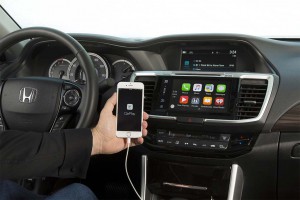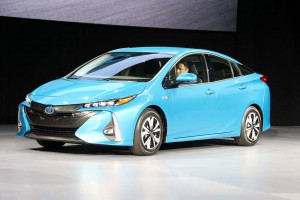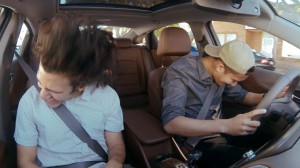Federal regulators are taking two seemingly opposite steps in the name of safety: they want mew battery-electric vehicles to make more noise, but they also want to silence some of those smartphone apps catching blame for distracted driving.
Both issues are expected to become more serious in the years to come, as in-car electronics become increasingly common and as normally quiet battery-powered vehicles gain more traction — but pose risks for pedestrians, especially the visually handicapped, who might not see them coming.
There’s been growing demand to lock out texting and other apps while a vehicle is moving, but the rules the National Highway Traffic Safety Administration wants to work on during the final months of the Obama Administration are also generating significant pushback.
According to NHTSA, 3,477 Americans died due to crashes caused by distracted driving last year, or roughly 10% of total fatalities. The overall highway death rate has been rising for several years, after a decade of decline – the numbers were up 7.2% in 2015 and jumped a full 10.4% during the first half of this year, with distracted driving taking a chunk of the blame, according to various safety advocates.
“With driver distraction one of the factors behind the rise of traffic fatalities, we are committed to working with the industry to ensure that mobile devices are designed to keep drivers’ eyes where they belong —on the road,” NHTSA Administrator Mark Rosekind said in a statement issued just before the Thanksgiving holiday.

Automakers could continue to make apps available through functions like Apple CarPlay -- but limit how they would operate while driving.
(GM allowed to delay Takata airbag recall. Click Here to learn why.)
The proposal would, if enacted, roll out in two stages, the first focusing on ways to make built-in in-car infotainment systems safer to operate. The second would focus on smartphone features.
Under the proposed government guidelines, a number of common smartphone functions would have to be locked out, whether by the smartphone itself or by systems put in place by auto manufacturers. These would include such things as the ability to type in text, browse the Internet, look at pictures and watch videos not directly related to driving.
The guidelines would permit a motorist to use a navigation app but would restrict how a motorist could interact with it, likely limiting data entry to voice controls.
The National Safety Council says it “shares NHTSA’s concern about the distraction of electronic devices used in vehicles,” as have other safety groups rallying behind the new government proposal.
(Auto safety legend Clarence Ditlow passes away. Click Here for a profile.)
NHTSA has been working with the auto industry to develop a more cooperative approach to safety since Rosekind took over as administrator two years ago. That has included the formation of a new consortium designed to push new safety-related technologies – such as forward collision warning with automatic emergency braking – into vehicles faster than would be possible through the traditional legislative process. But the new smartphone proposals appear to be generating a mixed response.

Toyota already uses a back-up warning on the Prius but would have to create noise when driving at speeds up to 19 mph.
“The fundamental direction is to keep your hands on the wheel, eyes on the road and minimize distraction and offer up other means of interaction, primarily voice,” said General Motors spokesman Vijay Ayer, who noted that with new systems like Apple CarPlay and Android Auto the maker can better regulate which smartphone apps will function in a vehicle – and how.
The problem is that there is currently no way to require motorists plug their smartphones in and switch to one of these new services – if they are available. CarPlay and Android Auto are just beginning to be offered in-car, though they are expected to become widely used in the years ahead.
Not everyone is pleased by the new NHTSA proposal on smartphones. The Consumer Technology Association, which represents smartphone and other technology developers and manufacturers, describes the guidelines as “regulatory overreach,” and “disturbing.”
“Rather than focus on devices which could reduce drunk driving, they have chosen to exceed their actual authority and regulate almost every portable device,” said Gary Shapiro, the CTA’s chief executive. In his statement he also asserted that NHTSA does not have the authority to dictate the design and functionality of electronic devices brought into a vehicle.
How the smartphone guidelines will shake out is far from certain. The agency now enters a 60-day comment period that would take the proposal into the new Trump Administration. The incoming president has already said he plans to call for reduced regulation, so whether he would try to stay NHTSA’s hand is far from certain.
There appears to be more broad support for the other new rules the federal safety agency wants to enact – in part because NHTSA is actually following a mandate set in place by Congress. It will require all Zero Emission Vehicles, or ZEVs, operating in electric mode to produce sounds meant to alert pedestrians and other motorists when running at speeds below 30 kmh, or 18.6 mph.
The agency claims the rules would prevent about 2,400 injuries annually. Delayed several times, they now are set to go into effect for all qualifying vehicles sold in September 2019 and beyond. By 2020, that is expected to include 530,000 vehicles. But with sales of hybrids, plug-ins, pure battery-electric vehicles and hydrogen cars gaining momentum, it could impact millions of vehicles annually over the next decade, some industry sources are forecasting.
The government estimates the cost to the industry at $39 million annually when it goes into effect, due to the addition of an external, weatherproof speaker. Some vehicles, such as the Toyota Prius, already produce sounds in certain low-speed operating modes, such as reverse. The U.S. Department of Transportation estimates the cost will be offset by preventing as much as $320 million in annual costs related to vehicle injuries.
While the auto industry is generally supportive, it wants the rules to provide manufacturers with some level of “flexibility to equip vehicles with sounds that are sufficiently detectable yet pleasant to hear; consumer acceptance is critical and that hinges on sounds not annoying people inside the auto,” according to a statement by the trade group, the Alliance of Automobile Manufacturers.
As with the smartphone guidelines, the new rules will be subject to whomever takes charge of the Transportation Dept. and NHTSA under the new administration.
(As more states legalize pot, concerns about driving safety rise. Click Here for more.)

